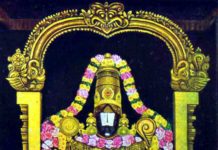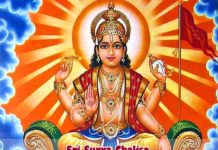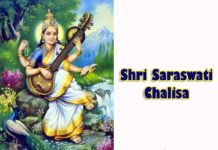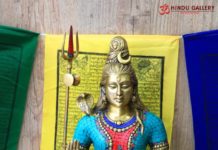Sri Shubha Kiruthu is the new year as per Hindu Calendar. The Hindu Calendar has sixty years each with a name and significance.
Some regions of India consider only Solar calendar to ascertain the run of a year; The other regions consider only the luni-solar calendar for the purpose. Hence there are two versions of Hindu new year celebrations.
Similarly, even rituals like marriage, Gruha Pravesh etc., are conducted only at nights in certain regions and only at day time in the other regions. This difference also occurs due to the following of the respective calendars (solar / luni-solar).
Sri Shubha Kiruthu and all the years as per Hindu Calendar commence with Chaitra month. The dawn of Chaitra is considered as the new year day. It is celebrated in different names in different regions. The rituals are also different.
However, there are common elements such as special prayer and worship to God, visiting temples, doing special poojas, wearing new dresses, getting blessings from the elders and partaking of food with family and friends with special dishes. Reading of almanac or panchangam denoting the prospects and goodness of the new year is also a predominant feature of the festivities.
The synopsis of the festivities across a few regions of India with respect to the celebration of Hindu New Year Sri Shubha Kiruthu is given in this narrative.
Ugadi
In the Telugu regions, the festival is called as Ugadhi. It means the commemoration of the beginning of Kaliyug. It is also called as Samvathsaradhi which means “beginning of the year”.
Special rangoli / muggulu are drawn in front of the house. The entrance of the house is decked up with mango leaves and palm leaves.

Bobbatlu, the sweet dish made of jaggery and coconut is made. However, the Ugadhi Pachadi made of tamarind, mango, neem flower, chilli, jaggery and salt signifying the combination of six types of tastes such as salt, hot, sour, sweet, tangy and bitterness is prominent. Other dishes such as Garalu (Vada) and Pulihara (tamarind rice) are also made.
Visiting temples, having darshan of Gods / Goddesses and doing archana are invariably done.
Ugadhi is on Saturday, 2nd April 2022.
Yugadhi
Similar to Ugadhi, Yugadhi also means the commemoration of the beginning of Kaliyug.
Special rangoils are drawn in front of the house. The entrance of the house is decked up with mango and palm leaves.

Special dishes such as Poli, Vada and Payasam are made. Visiting temples, having darshan of Gods / Goddesses and doing archana are invariably done.
Yugadhi is on Saturdayday, 2nd April 2022.
Gudi Padava
The festival is observed as Gudi Padava. It is considered as celebration of victory of Sri Rama over Ravana. It is also considered as celebration of harvest of rabi crops.
The houses are decorated with Thoran and Rangoli. A special gudi flag is made in yellow / red colour and decorated with neem and mango leaves. A small pot made of copper or silver is kept upside down on the flag.

The gudi flag is believed to ward off evil. Sakkar Bhaat, Shrikhand, Puri and Puran Poli are the special dishes.
Visiting temples, having darshan of Gods / Goddesses and doing archana are invariably done.
Gudi Padava is on Saturday, 2nd April 2022.
Sajubu Nongma Panba
The festival is celebrated as Sajubu Nongma Panba / Meetei Cheiraoba / Sajibu Cheiraoba. It denotes the first day of the year in Manipur.
The calendar is called Meitei Lunar. Raw rice, vegetables and fruits are offered to the God named Lainingthou Sanamahi who has derived his powers from all the Stars.

Only men of the house do the cooking while the ladies do the cleaning. Only even number of the dishes are prepared.
An area of 2×2 (feet) is cleared and sanctified with flowers at both the entrance and the rear of the house. The cooked food is offered to Gods in odd numbers at both the entrance and the rear.
Three Gods are worshipped, viz Kumsana Kumliklai (Lord of the golden year), Lamsenba Tusenba (Guardian of the Land) and Lammaba Tumaba (Lord of the land) at the sanctified area. Only the eldest son of the family does the offering.
It is believed that anything that happens on the new year day happens for the rest of the year. Hence the people feast with family and friends to retain the health and happiness.
After the feast, the family members climb small hillocks to pay respects to the hill deity. Prior to the day of festival, married women gift a piece of new cloth to their father and brothers as a custom.
Sajubu Nongma Panba is celebrated on Saturday, 2nd April 2022.
Cheti Chand
The festival is celebrated as Cheti Chand. This is the second day of the Shukla Paksha and the moon is visible only on this day after the new moon day.
It is also observed as the birthday of Sri Uderolal, the Sindhi Saint who was also called as Sri Jhulelal.

As per the legend, the Sindhis were ruled by a tyrant King who had forced them to convert to the other religion. They all prayed to the river God for forty days. At the end of forty days, they heard a celestial voice which said that a divine child would be born in Nasarpur as son of Mata Devki to protect them. The child was named Uday Chand. Sri Jhulelal was that child. “Jhulelal” also means “swinging child”. The Child grew up, performed many miracles and cured lot of ill people. When the time came, Sri Jhulelal also confronted the tyrant. The tyrant was forced to admit his defeat. He then treated Sindhi Hindus respectfully.
Sri Jhuelal is considered as the incarnation of Sri Maha Vishnu. He is believed to have born with the blessings of God Varuna (the God of rain). Sri Jhulelal was said to be born in 10th Century.
The festival also heralds the arrival of spring. All the water bodies are respected and worshipped by way of special poojas with kalash. They carry oil lamps, sugar, cardamom and fruits to the river Sindhu and perform poojas. River Sindhu is in Pakisthan.
Cheti Chand / Jhulelal Jayanthi is celebrated on Saturday, 2nd April 2022.
Chaitra Navrathri Puja
In some parts of North India, Chaitra Navratri Puja is celebrated for 9 days from the first day of the Hindu New Year. Sri Durgaa Maa is invoked for this festival.
The first day of the Chaitra Navrathri is considered to be the first day of origin of the universe. It is also the first day of the Hindi new year.
The festival commences with the keeping of the Kalash at the appropriahte time. The idol / picture of Durga Maa is placed in the puja place. Special sweets are prepared and offered as Neivedyam and partaken. Some people observe fasting for a session.
A clay pot with soil is sown with seven types of grain seeds is put there. A kalash with pure water is put. The coconut is covered with red cloth. Betal leaves, Mango / Ashoka leaves, a few coins and the grass named Dhurva are offered in the puja.
The slokas / mantras pertaining to each avatar of Maa Durga are devoutly recited. Poojas are done daily.

It starts on Saturday, 2nd April 2022 and ends on Monday, 11th April 2022. The muhurat time for commencing and ending the Vrat should be ascertained from the respective regional calendar.
The Chaitra Navratri Vrat comprises of festivals such as Shailaputri Puja, Sindhoora Tooj, Brahmacharini Puja, Gowri Puja, Saubhagya Teej, Chandraganta Puja, Kushmanda Puja, Vinayaka Chathurthi, Lakshmi Panchami, Naag Puja, Skanda Mata Puja, Skanda Sashti, Kathyayani Puja, Yamuna Chauth, Maha Sapthami, Kala Rathri Puja, Durga Ashtami, Annapurna Ashtami, Mahagauri Puja, Sandhi Puja and Sri Rama Navami. It ends with Navaratri Parana on 11th April 2022.









































